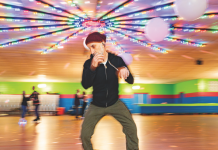IT’S SHORTLY BEFORE noon on a Wednesday in mid-July, and the Minnesota Orchestra is playing to a mostly empty hall. It’s a rehearsal for that evening’s performance, a mix of Broadway fare that includes Andrew Lloyd Webber tunes and a Jesus Christ Superstar medley, and the ensemble’s assistant conductor, Sarah Hatsuko Hicks, is putting the instrumentalists, as well as some guest vocalists and a 60-person chorus, through the paces.
Hicks is dressed in a blue T-shirt, rumpled white khakis, and black sandals that reveal painted toenails. Her hair is pulled back in a ponytail. Her tone is self-deprecating, her demeanor relaxed. But when a sound technician rushes up from the back of the house to tell Hicks that the tambourine is getting picked up on the choir mics, the thirtysomething conductor’s sense of humor unexpectedly pops up: “Rock on, warrior!” she shouts outs in mock praise, pumping her fist in the direction of the percussion section like a fan at a heavy-metal concert.
It’s hard to imagine Arturo Toscanini—or even Leonard Bernstein, for that matter—flashing the “devil’s horns” from the podium. But Hicks isn’t your typical conductor. For starters, her age, background, and even her gender make her an anomaly in the field. Hicks is one of just four women on the conducting staffs at the 26 largest orchestral associations in the United States, according to the American Symphony Orchestra League. (Only the Baltimore Symphony Orchestra has a female music director, appointed in 2007.)
But it’s her unconventional vision of what an orchestra should be that particularly sets Hicks apart from most of her professional peers. While other young composers want to leave their mark on Mahler or chamber music, Hicks wants to raise the bar for pops performances. She dreams of the day when classical musicians are as eager to explore the songs of, say, Björk as they are to play Brahms and Beethoven.
THE DAUGHTER of an American lawyer and a Japanese dancer, Hicks was born in Toyko but spent most of her childhood in Honolulu. Her parents’ musical tastes were eclectic, including not only classical fare, but also big band, Ravi Shankar, and classical Japanese music. Hicks spent her days practicing the piano and her nights watching MTV. She planned to become a professional pianist, but, at age 16, developed tendonitis. It was a crushing blow. Her musical career, it appeared, was over.
But Hicks’s father suggested there were other options. “‘Your hands can still hold a baton,’” she recalls him saying. Shortly thereafter, she recalls, her high-school orchestra teacher asked her to take over in the middle of a piece while he left the room. “Nobody taught me how to beat two-and-four,” Hicks says, “but it came to me,”
Hicks enrolled at Harvard University, earned a degree in music composition, and then began conservatory training at the Curtis Institute in Philadelphia. Her conducting teacher, a legendary German maestro, was no fan of women in classical music, however. “He basically thought women should be naked, pregnant, and at the stove,” Hicks recalls. Early on, he told her that women were weak and Asians unexpressive. “I knew he was trying to goad me,” Hicks says of the experience. “I learned not to cry. I learned to suck it up. If you’re in a position of authority, you can’t show weakness.”
Her tenacity ultimately paid off. In a field where competition is fierce and job openings rare, Hicks has managed to land staff positions with the Reading Symphony Orchestra, the Philadelphia Singers (the chorus of the Philadelphia Orchestra), and, most recently, the Richmond Symphony, where she was associate conductor. She joined the Minnesota Orchestra as assistant conductor in 2006 and remains the first and only female to hold a staff conducting position at the 104-year-old institution.
But Hicks doesn’t lose much sleep worrying about the glass ceiling for women in her field. “I can’t be anyone other than myself,” she says.
The bigger obstacle in Hicks’s professional path is tradition. Classical music is encrusted in ancient rites. Some are charming (standing during the “Hallelujah” chorus), but many are stifling (applause between movements is usually met with a withering glance from the podium). “There’s still an element of cultural elitism in the classical-music world,” Hicks says.
If orchestras are going to survive and thrive in the coming century, something needs to change. For starters, everyone needs to loosen up, Hicks says. “Can music be edifying and uplifting?” she asks. And how about just fun? That’s the question Henry Fogel, the outgoing president of the American Symphony Orchestra League, posed at the association’s last annual conference: “Symphonic music can and must explore the full range and depth of human emotion, including grief and tragedy,” he said. “But charm, wit, and humor are also parts of the human character, and they belong in our concert halls, too. Fun at a ‘serious’ concert is okay, folks.”
Hicks is leading that charge. In Richmond, she conducted a series of concerts called “Kicked-Back Classics,” which took place in a rock club and featured a chamber group playing Latin music (original compositions as well as arrangements) while bartenders served cocktails and audience members brought her shots of Wild Turkey. She and the Delaware Symphony Orchestra recently appeared at the Mann Center in Philadelphia, doing Pink Floyd covers with a band called the Machine, complete with a fog machine and laser show. She’s a big fan of pops concerts like “Broadway Rocks” and “To Boldly Go,” a recent Minnesota Orchestra program with a bill that featured music associated with Star Trek and other space-themed movies and TV shows. George Takei, who played Mr. Sulu on the popular TV show, made a guest appearance.
MANY CLASSICAL MUSICIANS, however, view pops programs with disdain. “Musicians aren’t crazy about [playing pops], because it’s not what they were trained to do,” explains the Minnesota Orchestra’s general manager, Robert Neu. Furthermore, what works for a jazz combo or a Broadway chorus may sound odd or overblown when scored for a full-size orchestra of nearly 100 string, brass, woodwind, and percussion players. “There are a lot of bad pops arrangements out there,” says Sam Bergman, a violist who hosts the orchestra’s Inside the Classics series with Hicks. Some conductors, he adds, call pops charts “football music” because the scores contain so many whole notes.
But Hicks believes that such objections to pops programming can—and should—be overcome. Pops arrangements, for example, don’t have to be dull. In 2006, the Minnesota Orchestra’s tribute to the music of ABBA featured music director Osmo Vänskä in a bell-bottomed suit and arrangements of such tunes as “Gimme! Gimme! Gimme!” by one of the maestro’s former colleagues in Finland. “Those arrangements were clearly by someone who knew how to write for orchestra,” Bergman recalls. “And that makes a big difference. It makes it more fun for us musicians. It makes it feel like we’re actually contributing.”
The ABBA show was also good at the box office: Ticket sales reached 96 percent of capacity. (The orchestra hopes to turn ’70s nostalgia into ticket sales again this month with a show celebrating the music of Queen.)
Hicks points out that the revenue produced by popular nonclassical shows can help underwrite more traditional programs that are expensive to produce yet unlikely to yield high ticket sales—a staging of La Traviata, for example, or a Mahler symphony that calls for full orchestra, vocal soloists, and a chorus.
But most important, Hick says, mixing Schubert and Sondheim, or brass quintets and “Bohemian Rhapsody,” in the same season or even the same concert is a way of mirroring modern listening habits. Her iPod is filled with songs by Sheerwater, Limp Bizkit, Frank Sinatra, Talib Kewli, Tarad des Haidouks, the Cowboy Junkies, and many other nonclassical musicians. Music services such as iTunes have made it easy for music fans to sample widely among genres, and that mix-and-match approach to listening is increasingly reflected in box-office purchases. “The people who are new to us definitely want to mix it up,” says David Sailer, who tracks subscription sales at the Minnesota Orchestra. “I definitely see the trend…. There’s a group of people who just want to go hear great music, and they’ll define it in the way they want to—and that’s a jazz performance, a presentation with Yo-Yo Ma, and Osmo or Sarah conducting the orchestra.”
In recent years, the Minnesota Orchestra has seen an influx of new, young players, many of whom seem willing to try new things and cross genre boundaries, Hicks says. And Vänskä’s embrace of ABBA and other nonclassical artists has helped elevate expectations for pops performances in Minnesota. Hicks admits it may be a long time before the classical world fully embraces the kind of dynamic, pluralistic approach to programming she envisions, but she’s willing to put in the time and effort to bring about the shift in mindset. “Most orchestras do a wide mix of classical, pops, and young people’s concerts,” she says. “But I think what’s likely to happen with the new generation of conductors who are crossing genres, is that you get more interesting collaborations. My interest is in ‘crossing the line.’ I specialize in the crossover.”
Joel Hoekstra is the managing editor of Minnesota Monthly.






